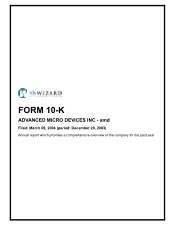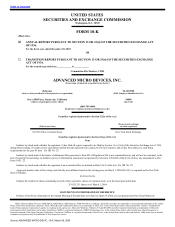AMD 2003 Annual Report Download - page 10
Download and view the complete annual report
Please find page 10 of the 2003 AMD annual report below. You can navigate through the pages in the report by either clicking on the pages listed below, or by using the keyword search tool below to find specific information within the annual report.
Table of Contents
Our x86 microprocessors for servers and workstations consist of the AMD Opteron and AMD Athlon MP processors. A server is a powerful computer on a
network that is dedicated to a particular purpose and stores large amounts of information and performs the critical functions for that purpose. A workstation is
essentially a heavy-duty desktop, designed for tasks like computer-aided design. We introduced our first 64-bit microprocessor for servers and workstations, the
AMD Opteron processor, in April 2003, an introduction date that we changed from our originally planned date due to a combination of factors, including the
state of the microprocessor market at the time the introduction was planned and our plans to introduce these products on 130-nanometer silicon-on-insulator, or
SOI, manufacturing process technology. Like the AMD Athlon 64 processors, the AMD Opteron processors for servers and workstations are based on the
AMD64 technology and are designed to run both 32-bit and 64-bit applications simultaneously. AMD Opteron processors are the first processors to extend the
industry-standard x86 instruction set architecture to 64-bit computing. AMD Opteron processors are available in one- to eight-way servers that can be used in a
variety of server applications, including business processing (enterprise resource planning, customer relationship management, and supply chain management)
and business intelligence. AMD Opteron processors are also available in one- to four-way workstation solutions that can be used in workstation applications such
as engineering and digital content creation software, and other information technology infrastructure applications such as intensive Web serving and messaging.
Our AMD Opteron and AMD Athlon 64 processors support HyperTransport ™ technology, which is a high-bandwidth communications interface we
developed, as well as integrated memory controllers that enable substantially higher performance than existing, non-integrated memory controller architectures.
We expect our advanced architecture to provide users with even greater performance improvements as operating systems and software applications begin
leveraging the benefits of our 64-bit architecture. To that end, in April 2002, we announced a collaboration with Microsoft to incorporate 64-bit support into the
Windows operating system. Microsoft has indicated that they intend to release the 64-bit version of Windows XP in 2004. We believe that the backward
compatibility of these processors will allow users to migrate more easily from current 32-bit operating systems and applications to future 64-bit operating
systems and applications on a common hardware platform.
We also sell chipset products and make available motherboard reference design kits, designed to support our microprocessors for use in PCs and embedded
products. A chipset provides the interface between all of a PC’s subsystems and sends data from the microprocessor to all the input/output and storage devices,
such as the keyboard, mouse, monitor and hard drive. The primary reason we offer these products to our customers is to provide them with a solution that will
allow them to use our microprocessors and develop and introduce their products into the market more quickly. We report the revenue from sales of our chipset
products in our Computation Products segment.
We believe the key factors impacting our ability to increase microprocessor revenues in 2004 are: our ability to increase market acceptance of our AMD
Opteron and AMD Athlon 64 processors and to produce them in a timely manner on new process technologies, including 90-nanometer SOI technology, in the
volume and with the performance and feature set required by customers; market acceptance of the newest versions of our AMD Athlon XP processors; growth in
unit shipments of our microprocessor products; and our ability to maintain or increase average selling prices for our microprocessor products.
In 2004, one of our goals is to increase market acceptance of our AMD64 technology, particularly in the enterprise segment. To that end we intend to focus
on developing and introducing products for the server and workstation markets and increasing our share of these markets. Although we will continue to provide
our AMD Athlon MP products pursuant to market demand, we intend to concentrate on developing and producing new versions of our AMD Opteron
microprocessors for these markets.
5
Source: ADVANCED MICRO DEVIC, 10-K, March 09, 2004























